Irish Coinage
____________________
Milled Coinage
Irish Milled Coinage (1660-1823)
Index:
On this Page:
Related Pages :
©
1999 - Copyright
John_Stafford-Langan
Version 1.09a
3 February , 2002
Regal Copper under the Stuarts (1660-1688)
Charles II 1660 - 1685
Charles II granted a patent to strike farthings for Ireland to Sir Thomas Armstrong in 1660. This issue was similar to the farthings of James I and Charles I from before the English Civil War. The issue was prohibited by the Governor of Ireland in 1661 and it does not appear to have been issued in large number nor to have circulated widely before this prohibition.
The period beween 1657 and 1674 (just before and after the restoration of the monarchy in England) is characterised by the issuing of numerous small penny and twopenny tokens. There are over 800 different issues and they include examples from every city, almost every town and a few villages in Ireland. The tokens of this period will be covered in Irish Tokens (1200 to 1858).
Significant among the token issues are the anonymous St Patrick's farthings and halfpennies. Unlike the normal tokens of the period these coins are not attributed to an issuer. The similarity to the contemporary token issue of Richard Grenwood of Dublin cannot be ignored and it is highly likely that the reverse design is derivative, though whether Grenwood was involoved in their manufacture or issue is unknown.
They are also significantly heavier and were clearly produced in considerable numbers as there are many die variations. These tokens are often included in the Irish coin series (along with the later Voce Populi tokens) as they were clearly a significant issue and as they seem to have circulated without difficulty despite being unatributed.
In 1680 Charles II granted a patent to strike halfpennies for Ireland. This patent was granted to Sir William Armstrong (son of Sir Thomas Armstrong, above) and Colonel George Legg. There followed an issue of halfpence in copper dated each of the years 1680, 1681, 1682, 1683 and 1684.
This was generally a good quality coinage and it is likely that the quality of the pieces quickly eliminated the much lighter and poorer quality tradesman's tokens that had circulated before 1680.
James II - 1685-1688
After the death of Charles II in 1685 the patent was confirmed by James II and a similar coinage of halfpennies in James II's name was issued dated 1685, 1686, 1687, and 1688.
The coinage ceased in 1688 following James's abdication and did not recommence until 1692 (see below).
Gunmoney (1689 - 1690)
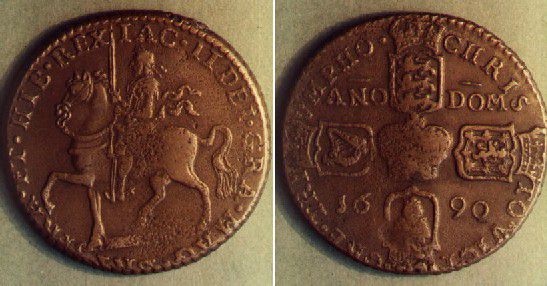
Gunmoney Crown - 1690
Following his abdication in England, James spend some time in France and in an attempt to regain his throne he landed in Dublin in 1689.
To support the cost of his campaign in Ireland James issues a coinage of brass in the denominations of halfcrown, shilling and sixpence.
The so-called gunmoney coins were not only made of melted cannon as is the folk-tale but were made from brass from a variety of less romantic sources including church bells.
Gunmoney is curious in that it was meant as a 'token' coinage and was dated by month as well as year so that it could be redeemed by James after he regained the English throne in the order in which it had been issued.
James II Gunmoney Large Shilling - Dec 1689
The Dates on Gunmoney
For dating purposes it is important to remember that in 1689 in Ireland the year ended in March so that coins dated March 1689 and March 1690 were actually issued at the begining and end of the same month.
The order of issue was:
June 1689
.
.
December 1689
January 1689 - - - (this is Jan 1690 in our calendar)
February 1689 - - - ( " " Feb. 1690 "
" " )
March 1689 - - - - ( " " March 1690 "
" " )
March 1690
April 1690
.
.
October 1690
Small Issues May - Oct 1690
James II - Gunmoney - Small Shilling - May 1690
In April 1690 James was running short of brass and he reduced the size of the gunmoney coins and issued a smaller shilling and halfcrown, there was an overlap between the introduction of the small coins and the cessation of production of the large ones.
The sixpence was not produced with the 'small' issue.
A crown dated only by year (1690) (pictured above) was introduced in about May 1690.
Following James II's defeat at the Battle of the Boyne in July 1690 he fled back to France, but gunmoney continued to be issued in his name in Limerick (the Dublin mint having been captured).
Limerick and other Civil War Issues
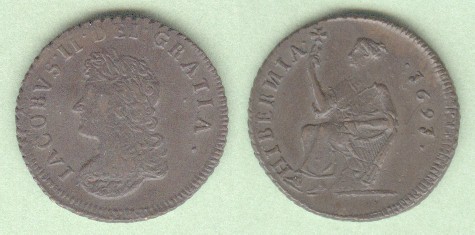
Limerick Halfpenny 1691
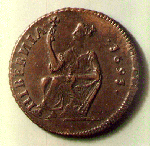
Reverse of a Limerick halfpenny, 1691
In March 1690 James also issued some pennies and halfpennies in pewter which are scarce and a number of patterns for coinage in pewter and white metal.
Among these was a crown of similar design to the 'gunmoney' issue but of better workmanship.
After the Battle of the Boyne in July 1690 the mint at Limerick continued to strike coins in James's name.
William and Mary, however, revalued the gunmoney coinage following which the mint at Limerick issued a short series of halfpennies (pictured above) and farthings struck from gunmoney coins and dated 1691.
Limerick fell to Willaim on Oct, 3, 1691 and the Limerick issue in the name of James II ceased.
William & Mary (1692 - 1694)
Halfpenny of William and Mary of 1693
William and Mary ascended to the English throne in 1688 but it was not until the end of 1691 that they had complete control of Ireland.
In 1692 they resumed a copper regal coinage of halfpennies very similar to the style of the previous coppers of Charles II and James II.
These copper halfpennies were issued for three years and are dated 1692, 1693 and 1694.
William III (1696)
William III halfpenny of 1696 - draped bust type
Mary died in 1694 and William III continued his reign alone. In 1696 he issued a halfpenny of a similar type to the earlier coins.
After 1696 no further coinage was struck for Ireland until 1722.
William Wood and his coinage (1722-1724)
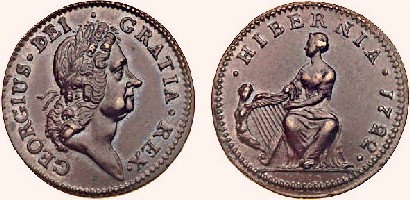
A 'Wood's' halfpenny of 1722 (first type)
In 1722 William Wood purchased a patent for striking copper halfpennies and farthings for Ireland.
Wood was a mine owner and entrepreneur and envisaged making a large profit on the difference between the cost of the metal, patent and workmanship and the face value of the coins.
The coins were first issued in 1722 in small numbers and during 1723 they were issued in much larger numbers.
Wood's Halfpenny Type II - 1723 - no pellet before rev
legend
The coins were considered sub-standard by the population of Ireland (mainly Dublin) and the king was petitioned to revoke the patent.
The patent was surrendered by Wood in 1724 in exchange for a pension from the Irish Government.
As Wood's coinage was unpopular in Ireland much of the issue was shipped to the American colonies where numismatists include it in their 'colonial series'.
In fact Wood's coinage was of a good standard and would have only turned a small profit for Wood on the basis of the original patent. The pension was a significant profit on the deal.
Wood issued halfpennies and farthings of two types in 1722. The coins of 1723 and 1724 are of the second type only.
A number of patterns and proofs exist for this coinage.
George II regal copper (1736-1760)
George II - Farthing 1737 - Silver Proof
In 1736 George II introduced a new coinage in copper for Ireland. It was to consist of halfpennies and farthings though the farthing didn't appear until 1737.
The coins for this issue were made in London in the Royal Mint and were shipped to Ireland to be placed in circulation.
These regal coppers were well made and of good weight so they quickly became accepted in place of the copper tokens that had characterised Irish currency after the failure of the 'Wood's' coinage.
The George II coppers were produced for a number of years until his death in 1760. Not every date is represented in the series. The halfpennies were generally issued in much larger numbers and are consequently more common.
Proofs in Silver (see picture) were issued in the first year of production of each denomination. Proofs in Copper were issued in these years and several others.
About a quarter of the total production is represented by one year, 1760, (illustrated) which also uses an older bust than the other years.
Voce Populi Coinage (1760)
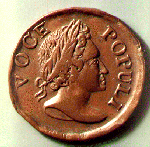
Obverse of a 'Voce Populi" Halfpenny of 1760
In 1760 a Dublin button maker produced and issued a series of copper halfpenny and farthing tokens with the obverse legend VOCE POPULI in place of the regal title and a reverse design of Hibernia seated similar to that on the English copper of the time.
There has been much speculation as to the meaning of the legend on the Voce Populi issue and there are two general opinoins.
The first opinion is that they represent a voicing of the Irish continuing suport for the young Stuart pretender to the English throne. The alternate opinion is that the shortage of change in Ireland as the regal coppers had not been issued since 1755 was the reason for the issue and the 'voice of the people' refers to their need for change.
The Voce Populi coins made their way to America where like the Wood's coinage they are considered part of the colonial series.
The Voce Populi coinage is considered part of the regular coinage of Ireland rather than as part of the token series because they do not carry details of their issuer and because they had no mechanism for redemption.
There are a number of varieties of the Voce Populi coinage including a piece with the date 1760 placed so badly on the die to appear to be dated 1700 and another with the legend VOOE POPULI where a die crack caused the 'C' to appear as an 'O'. The picture above is an example of this piece in an early die state before the crack became severe. In a recent conversation an American numismatist suggested that the VOOE error is actually an O entered into the die in error and that the apparently earlier coins are in fact later coins after a repair had been carried out on the die.
George III regal copper (1766-1782)
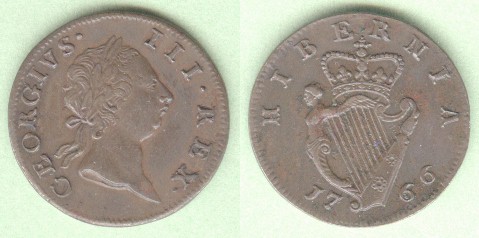
George III - Halfpenny - 1766
In 1766, six year after coming to the English throne, George III produced an issue of copper halfpennies for Ireland (illustrated). These coins are similar in design to those of George II. The farthing denomination was not struck. The issue was continued in 1769 and second issue the same year with some modifications to the bust of the monarch was also produced. The design was modified again in 1774 and coins were issued dated 1774, 1775, 1776, 1781 and finally in 1782.
A number of proofs exist of these coins the commonest of which are of the 1775 (illustrated) and 1782 dates.
The size of the issue of these halfpennies was not sufficiently large to provide change for the Irish economy and during the letter years of the issue and subsequently a large number of contemporary copies were made in Ireland.
The standard of workmanship in the contemporary forgeries varies greatly; some specimens being as well made as the official Royal Mint pieces and others being very poorly executed and obviously much lighter and thinner.
The act of forging regal coinage carried a severe penalty so the forgeries began to carry a number of legends other than the regal one. Some spurious legends are biblical and others are simply jumbled letters. The reverse legend HIBERNIA is similarly altered on some specimens.
A number of these forgeries made their way to America and they are included in the colonial series. As is the way with such things the Irish forged coppers with US attributable legends such as 'George President' or 'George Washington' (instead of 'Georguis III Rex') are much more sought after than the coins with Irish or English references in their legends despite being no more scarce.
By the end of the 1780's the need for small change became desperate both in Ireland and England as King George III had become mad and was unable to sign any coinage acts. The regal prerogative over the right to mint coin having been carefully guarded by the monarchy while other trappings of power devolved to Parliament. This resulted in an extensive series of copper tokens being issued in this period and up until about 1804 though the later pieces are often dated before 1794 to avoid the more severe penalties to restrict tokens introduced in that year. The tokens of this period will be covered in: Irish Tokens (1200 to 1858)
Bank Tokens and Soho Coppers (1804-1813)
Six Shilling Bank Token of George III of 1804 (specimen)
By the early 1800's the poor state of the currency in Ireland was placing a severe restriction on the functioning of the Irish economy with a mixed variety of foreign coins of varying quality silver content making up the middle tier of the circulating coinage. The lower tier being made up of a series of poorly made copper tokens and even poorer forgeries of these tokens.
Only the gold in circulation (which was primarily English, but included smaller quantities of many foreign coinages) was of good quality but it was difficult to obtain good quality change for gold and it carried a significant premium in exchange. Banknotes also began to appear in Ireland at this time.
The Bank of Ireland tried to aleviate the problem by importing quantities of Spanish (or South American) 8 real pieces which by this time had become one of the standard coins of the world.
However as the price of silver against gold was varying widely at this time it was difficult to establish a constant value for these peices as the country would alternatively be flooded or drained of the coins.
The bank decide to restrike the coins with a higher face value than was appropriate for their intrinsic worth and issued a large quantity of six shilling coins with the design struck over the spanish pieces. The pieces were not universally popular but did stabalise the economy for a time. The restriking was carried out by Mathew Boulton in his private mint in Soho in Birmingham as the Royal Mint had no free capacity.
In 1805 and 1806 the Royal Mint authorised Mathew Boulton to strike an issue of copper pennies, halfpennies and farthings for issuing in Ireland.
The Bank of Ireland continued its production of bank tokens in silver with the release of a five and ten pence coin dated 1805 and 1806. The Act authorising the tokens was only effective for 1805 so the bank quickly redated the coins to 1805 and continued to issue these tokens dated 1805 during 1806, 1807 and 1808.
In 1808 a thirty pence (half a crown) token was added to the series and a final issue of 10 pence tokens occurred in 1813.
Mathew Boulton also struck an issue of copper pennies and halfpennies in 1805 and farthings in 1806 in Soho which were official regal coinage and not of token status. These copper issues also occur in proof or specimen strikings in copper, bronzed copper, copper gilt, silver and gold. The currency issues have an engrailed edge (i.e. a grove cut into the edge around the coin) with oblique milling within the engrailing. The proof and specimen coins occur with plain edges and with the engrailing. Some proofs, typically the gilt and the silver and gold examples were issued in bonze cases or shells. Examples with the original shells command a better price than the coins without the shells.
Both the bank tokens and the 'Soho' coppers were struck in a number of specimens and proofs. The coin illustrated above is an example of one of 1,000 specimen strikings of the 1804 six shilling piece. These specimens are generaly prooflike and are often called proofs.
George IV regal copper (1822-1823)
Irish Penny of George IV of 1822
In 1822 and 1823 a small issue of pennies and halfpennies was released for use in Ireland by the Royal Mint.
By this time the normal English currency, which had been reformed in 1816, was circulating in Ireland along with an extensive series of banknotes of the numerous private banks in Ireland.
The coinage also consisted of a farthing which was not issued and only specimens or patterns exist.
Proof strikings of the penny and halfpenny exist for both years of issue and there is a scarce pattern penny with a narrower harp that the normal issue.
In 1826 the Irish currency was formally abolished and the Irish pound which had been valued a few pence below the sterling pound was brought into line and ceased to exist as a seperate denomination.
From 1826 until the founding of the state the English currency was also issued in Ireland for circulation here. From 1928 when the Irish Free State issued its own currency it was still guaranteed in London in sterling until 1960. English coins and banknotes circulated freely in Ireland until 1978 when the Irish pound joined the EMS and the currencies diverged. Low denomination English coins are still commonly accepted in Ireland and mix freely with the Irish copper coins.
The Irish coinage since Independence is covered in